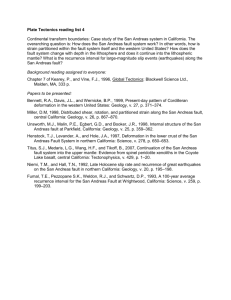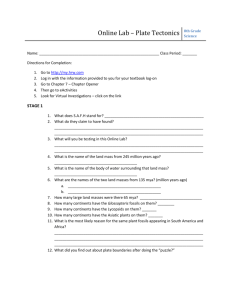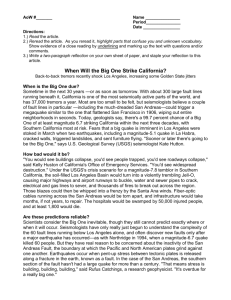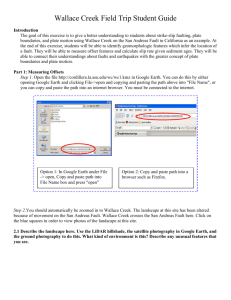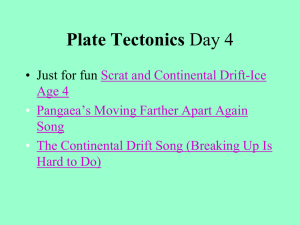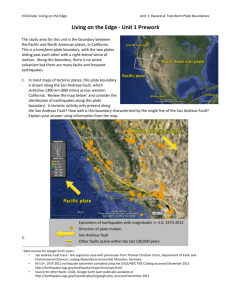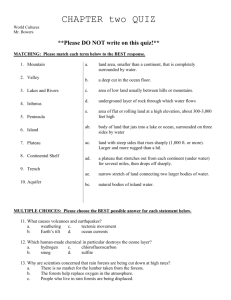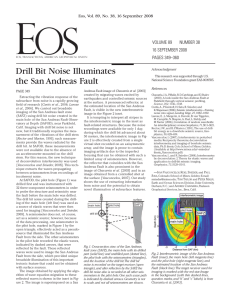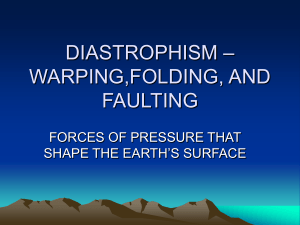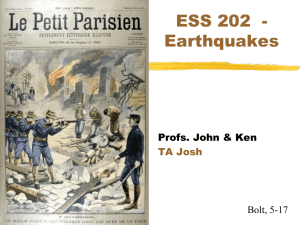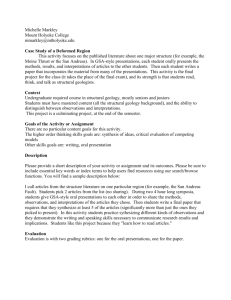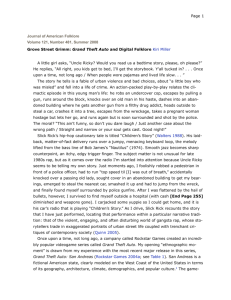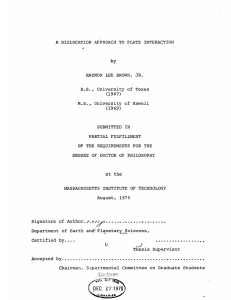SanAndreas_Out
advertisement
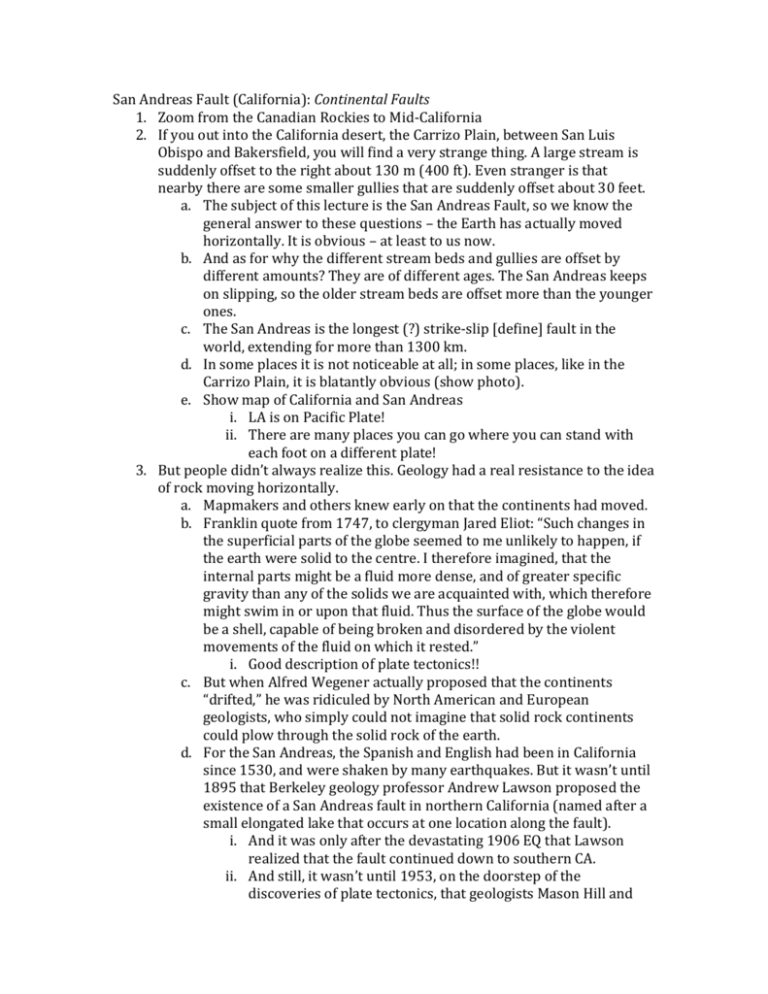
San Andreas Fault (California): Continental Faults 1. Zoom from the Canadian Rockies to Mid-California 2. If you out into the California desert, the Carrizo Plain, between San Luis Obispo and Bakersfield, you will find a very strange thing. A large stream is suddenly offset to the right about 130 m (400 ft). Even stranger is that nearby there are some smaller gullies that are suddenly offset about 30 feet. a. The subject of this lecture is the San Andreas Fault, so we know the general answer to these questions – the Earth has actually moved horizontally. It is obvious – at least to us now. b. And as for why the different stream beds and gullies are offset by different amounts? They are of different ages. The San Andreas keeps on slipping, so the older stream beds are offset more than the younger ones. c. The San Andreas is the longest (?) strike-slip [define] fault in the world, extending for more than 1300 km. d. In some places it is not noticeable at all; in some places, like in the Carrizo Plain, it is blatantly obvious (show photo). e. Show map of California and San Andreas i. LA is on Pacific Plate! ii. There are many places you can go where you can stand with each foot on a different plate! 3. But people didn’t always realize this. Geology had a real resistance to the idea of rock moving horizontally. a. Mapmakers and others knew early on that the continents had moved. b. Franklin quote from 1747, to clergyman Jared Eliot: “Such changes in the superficial parts of the globe seemed to me unlikely to happen, if the earth were solid to the centre. I therefore imagined, that the internal parts might be a fluid more dense, and of greater specific gravity than any of the solids we are acquainted with, which therefore might swim in or upon that fluid. Thus the surface of the globe would be a shell, capable of being broken and disordered by the violent movements of the fluid on which it rested.” i. Good description of plate tectonics!! c. But when Alfred Wegener actually proposed that the continents “drifted,” he was ridiculed by North American and European geologists, who simply could not imagine that solid rock continents could plow through the solid rock of the earth. d. For the San Andreas, the Spanish and English had been in California since 1530, and were shaken by many earthquakes. But it wasn’t until 1895 that Berkeley geology professor Andrew Lawson proposed the existence of a San Andreas fault in northern California (named after a small elongated lake that occurs at one location along the fault). i. And it was only after the devastating 1906 EQ that Lawson realized that the fault continued down to southern CA. ii. And still, it wasn’t until 1953, on the doorstep of the discoveries of plate tectonics, that geologists Mason Hill and Thomas Dibblee realized that an enormous amount of lateral motion had occurred on the San Andreas. iii. We now know there have been at least 550 km of offset across the fault. 4. Of course – the San Andreas keeps sliding. Or rather, the Pacific Plate keeps sliding northward relative to the North American plate. The rate is such that the San Andreas Fault is not that old, geologically speaking. In fact it is only about 40 million years old. So, what was along the west coast in California before the San Andreas fault? a. A clue comes from the existence of the Sierra Nevada mountains (discussed later in Yosemite) – formed from Subduction Zone volcanism! b. Also, extinct volcanos, in places like Mono Craters and Mammoth Lakes (well, mostly extinct!) c. So, this was once a subduction zone. But what happened? i. This clue is the Juan de Fuca plate – all that is left ii. California rode over the plate and even the ocean trench iii. We can see the body! Show seismic tomography of Farallon. iv. Show cartoon of transition of plate boundary v. In fact, the northward motion of Pacific plate is ripping off Baja California vi. (show Tanya’s demo) vii. LA will be adjacent to SF in about 13 million years 5. But there have been no shortage of mysteries and problems – (often the case with science – the more you know, the more you know you don’t know). [Did I do the story of Socrates in HTEW?] a. Q: Rates don’t match! NAmer/Pac plate motions at location of San Andreas is about 4.5 cm/yr (2 in/yr), but motion measured along the fault is only about half as much (2.5 cm/yr) i. A: Distributed deformation over wide SAF Zone, including other faults (Garlock, Hayward, Calavaras, etc.) ii. Show PBO GPS map b. Q: Fault should lock up and slip occasionally in large EQs: true some places but not others. Why does the fault “creep” quietly in some locations? i. A: SAFOD drill core: serpentinite and talc! ii. What’s more, the strange seismic tremor that has recently been observed (explain) might be due to a mineral transformation of existing minerals to flat minerals like talc. 6. Slip occurs differently in different locations: a. San Francisco (1906; 1989; other faults; Tomales Bay) b. Parkfield (prediction efforts) c. SoCal (bends cause San Gabriel Mtns and Salton Sea (more about this in talk on Dead Sea). d. Show SCEC animation of predicted wave propagation along fault and bad news for LA! 7. There are only a few long continuous faults on land. a. Lots of subduction zone faults UNDER continents (Japan, Oregon/Washington, etc), but not seen at surface b. So, not too many to choose from for the rest of the Top 5: i. Anatolian Fault (1999 Izmit; breaking westward; next spot is Istanbul) ii. Alpine fault (tearing New Zealand in half) iii. Denali Fault iv. Dead Sea Fault v. (Special Mention: Europa) Questions: 1. Why is it not quite accurate to say, as is sometimes heard, that “Los Angeles will sink into the ocean?” 2. There have been volcanoes in places like New Mexico in the not too distant past? How might this be related to the uplift of the Colorado Plateau?
